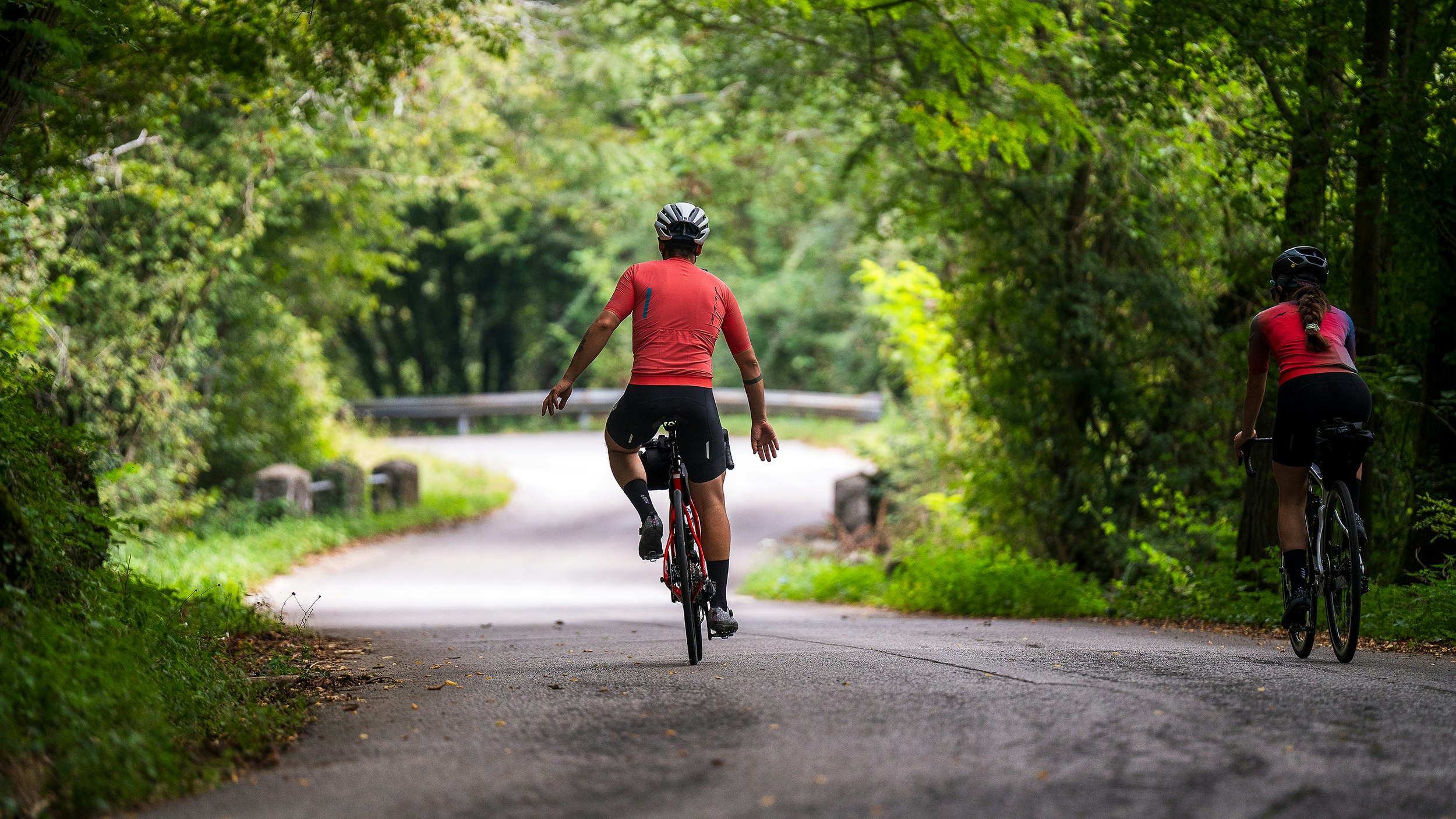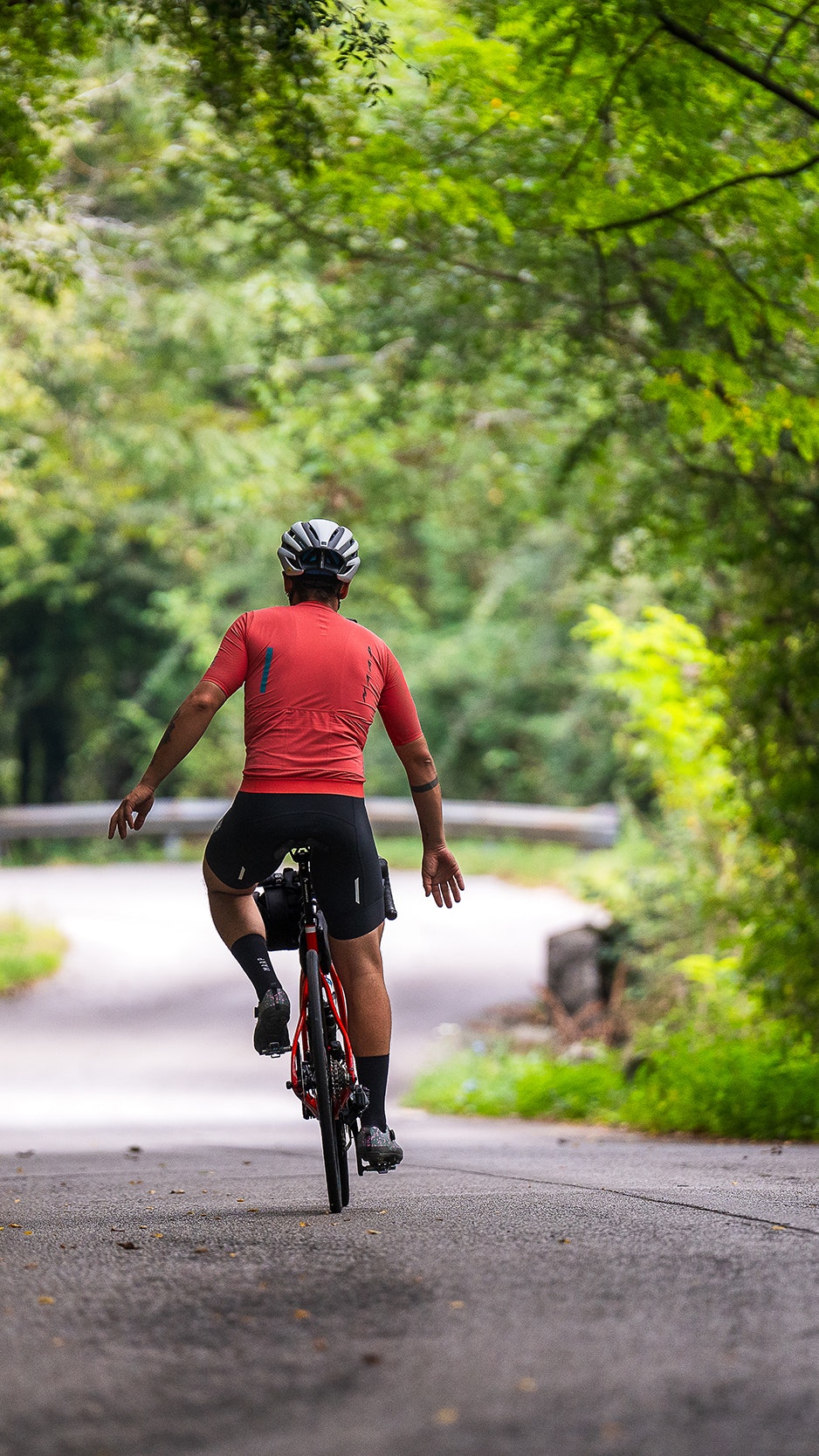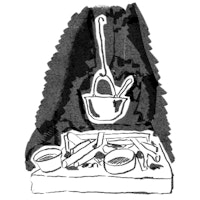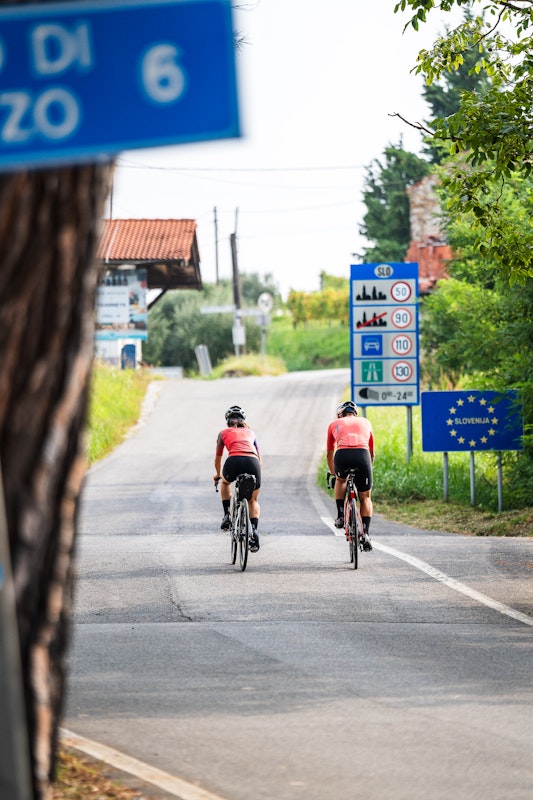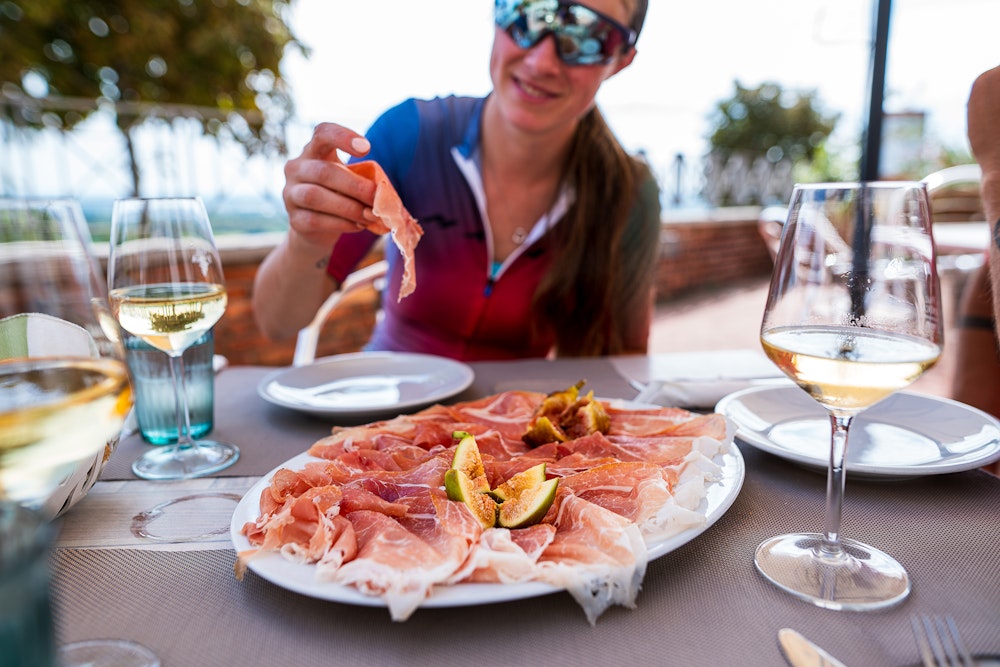
Enjoy the silence
The great loop of the hills of Friuli.
Period
Apr - Nov
Elevation difference
7373 m
Total Length
360 km
Duration
4/6 Days
I
Enjoy the silence
00
Intro
01
From Udine to Cividale
02
Il Kolovrat and the Valli del Natisone
03
The alta Val Torre
04
Between Tagliamento and Arzino and the hills of San Daniele
What a place! It’s something that never ceases to amaze. I have travelled the length and breadth of it and cycled all over it for several years now, but every time it’s a new discovery. To get away from the daily grind of the racing world, I decided, between the end of the Giro d’Italia and the start of the Tour de France, to organise a four-day cycling trip far away from all the routine. I decided to have four days to myself – but this is a trip that can also be done in five or six days, depending on taste, fitness, and available time – to dedicate to the Friulian sky, to the views that give you no choice but to stop at a hairpin turn and look out as far the horizon stretches. To dedicate time to those glimpses that become dear to whoever lives here, to whoever is just passing through. To dedicate time to those places that are not to be forgotten and that, every time you see them, depending on the season, produce a different feeling in your eyes and taste buds. To dedicate time to silences only interrupted by the sound of a few animals. to dedicate time to the intriguing bilingual road signs, in Friulian and Italian or, especially on the borders, in Italian and Slovenian.
I decided to take a break from everything, and the best way is to do so, is in a place that literally says: ‘Do you feel like getting away from it all, minding your own business, eating well, and drinking, if possible, even better? This is the place for you, this is Friuli’.
I’ve chosen a light menu for today. I am not talking about food, or rather, I’ll talk about that later. I’m talking about the itinerary. To link the capital of Friuli to the small town almost on the border with Slovenia, I chose a route that will take me through the vineyards, take me into what here is often still called Yugoslavia, climbing the ascent to passo San Nicolò, and reaching the Santuario of Castelmonte, and then swooping down to Cividale.
I’m properly stoked as I set off. Stoked on caffeine. I advise everyone, starting their tour from Udine, to go through the centre. Early in the morning, this means quietly choosing any bar between Piazza San Giacomo and the Loggia del Lionello, looking around and noticing how much there is of Veneto here, in this large town that is still people-friendly. Even, the local ladies have an accent that sound Venetian. Carefully cross the streets paved with stone slabs, and look up to the sky.


The spectacle before my eyes explains some of his frescoes. There’s a pleasant breeze, gently pushing me outside the city walls. Pradamano, Manzano, Buttrio: I cross these towns, riding along the cycle path that takes me towards a road that cuts into the first areas of Collio. Stretches of land lying on hillsides full of vineyards: castles, large villas to be photographed and one agriturism after the next, so many you almost feel guilty not to stop to have a glass of wine.
Once you leave Cormòns, you travel fast and smooth towards Slovenia. At San Floriano del Collio, you start with the first climbs at Ceglo, and then Medana, where, at the top of the hill, you seem to have a view of the whole world. From here, you return to Italy, first by taking a very fast descent and then crossing a road that takes you towards the old boundaries, once trodden by cross-border workers. I stop near a lady who’s standing in front of the old customs building, selling apricots and cherries. I think it’s the same lady you find autumn, with baskets full of chestnuts and porcini mushrooms.
I’m riding back into Italy and, when I read a sign saying Prepotto – welcome to the land of schioppettino, I suddenly feel thirsty for something other than the usual water bottle with minerals and sugar. I could finally stop and have a glass, or a taj as they call it here, of Schioppettino, but one would lead to another and there is still a long way to go. It is better to save the best for last, when I get to Cividale.
The town of Prepotto is amidst the vineyards. I cross the Ponte dello Schioppettino, over the Judrio river, flowing with its frothy waters. Beyond Albana the road gradually begins to climb, in a quiet and very green setting.
There are no cars, just a few cyclists passing me at double the speed and the refreshing gusts of wind. Then, from Podresca, the climb gets more serious: it’s the Passo di San Nicolò, five rather challenging kilometres uphill. A signpost indicates an average of over 8% inclination, with points reaching 12%, but my cycling computer actually reads as much as 14% at times. One hairpin turn after another, the heat and strain are rewarded by the amazing view. From some angles you can look out to the sea, from others you see the Santuario of Castelmonte up on the mountain. Arriving at the summit, where the Dutchman Koen Bouwman won the 2022 Giro d’Italia, I enjoy a snack in one of the restaurants: cherry and elderberry strudel, ‘we’ve picked the berry ourselves’, the owner tells me.
Back on my saddle, I face the last descent of the day, towards Cividale, heart of the Longobard civilisation. After a glance at the Natisone river and the Ponte del Diavolo, and after looking for a place to sleep, comes the moment I’ve been waiting: a plate of gnocchi (depending on the season, ask for pumpkin, chestnut, radicchio...) and a glass of Schioppettino, to finish off with strucchi and gubana, accompanied by a nice glass of grappa. Another way to get over a hard day’s work.
The Kolovrat is just like the people of Friuli: hard, almost biting, but when you climb it and reach the top, it welcomes you and offers breathtaking views beyond the border. The Natisone valleys have Slavic and Friulian names that seem to come out an old scary tale. You’ll never get thirsty in a place like this. There is water everywhere, it’s a lucky season, and drinking fountains are scattered all along the route.
You start out from Cividale and I recommend that you stop at some bakery or pastry shop, ask for strucchi and gubana (after you’ve recharged your batteries for today’s stage) and have a parcel made to send to friends and relatives: they’ll be grateful for the rest of their life. Leaving Cividale the road is always well paved, the view is a feast for the eyes, that satisfies the mind and sets the imagination loose.


These are gentle climbs, a prelude to what awaits me after the turn for Clodig: the ascent to Kolovrat. First though, where the road flattens out a little, I pass through what looks like a ghost town with a wonderful name: San Volfango. The climb is tough, but if nothing else, you will have plenty of time to admire what’s around you: the Valle del Natisone attracts and inspires me, the farms bring a smile to my face. After the first challenging part, the climb becomes easier and, before the final kilometres, you can catch your breath. At the crossroad towards Drenchia, even if one is quite tempted to change route, it’s time for the first, tough climb. Having reached the Rifugio Solarie, there is a fountain where you can fill up your water bottles or, alternatively, take a short break and have something to eat.
The last stretch is undoubtedly the most evocative, but very tough on the legs. Here’s where the real racers have passed, you can tell by the graffiti on the asphalt. Those dedicated to Novak and Mohoric, local champions, are the most frequent. One last kilometre with double digit gradients, and nothing else to say, except that you’ll be moving at a walking pace as you go up this road.
You descend on the Slovenian side, that would be really tough on the legs if you were ascending it. You return to Italy, crossing the green Valle del Natisone once again. You climb again, towards Canebola: this too is a hard climb, but if done at the right pace you will be able to enjoy the view. The summit and then the dive towards Faedis, where a room to sleep and a well-deserved dinner awaits me – among the local specialities, order some frico and you won’t go wrong –.
Altimetrically speaking, this is going to be the most difficult day. The track resembles the end stage of a great Ardennes classic, with the difference that in Belgium they can only dream of a frico like the one you find here!
We set off again from Faedis, another of those names that seem to come straight out of the woods, and here there are woods as far as the eye can see. There is a lot difference in altitude to cover today, but it is all spread along a continuous up and down in the midst of woods that appear somewhat grim and threatening, but which, when you are in the midst of them, instead of making you scared, encourage you to climb further… and further.
The road, which for the first stretch retraces backwards the last portion of the yesterday’s itinerary, immediately starts climbing when we are still in the village. In Via dei Castelli, the houses to the right and left start to disappear as if in a dream and the surroundings turn into trees. There are seven, steep kilometres to Canebola. Get yourselves organised: you’ll be cycling under the sun and the asphalt is rough. As you get to the village, it all seems to be over, but in fact there’s more to go, a few hairpin turns where you can take a breather and then a straight stretch, one of those that your legs will remember.
I climb to the top and, at Bocchetta di Sant’Antonio, and what I see is idyllic. There is the usual vastness of the view that makes almost all the Friulian mountains famous: I can see Monte Canin, one of the region’s best-known peaks, on one side, and exactly on the opposite side the plain, with Udine silhouetted against the Bassa Friulana, and then the sea. On a particularly lucky day, looking south-east, one can even see the Gulf of Trieste.


I cycle onwards. The road to the Porzûs crossroads becomes winding; blackberry and elderberry bushes almost invade the roadway and seem like outstretched arms trying to snatch you off your bike. The asphalt is uneven at times. The track goes up and then down again, until the fork that says Attimis to the left and Prossenicco to the right. My itinerary pushes to the right, but first a word of advice: if you get hungry, and want to make a short detour, go down towards Borgo Salandri and you will find a well-known trattoria. Here, if you want to trust a local, at Barbe Blas restaurant you’ll find a frico you won’t forget. Back on our track, on the way to Prossenicco, on a midsummer afternoon there are no cars, only a few cyclists, a farm vehicle loaded with wood, and a roe deer, whose bleat breaks, for the first time, the absolute silence all around. After a continuous up and down, all in all quite bearable for my legs, we finally see Prossenicco, one of the hot spots of our journey, a small village in the midst of the intense greenery of these hills. As soon as we enter, we find a meeting point for cyclists, set up as a landmark for those who want to venture out on mountain bikes along the many paths in the area.
‘Once upon a time,’ a local gentleman tells me, “Back in the days of the Cold War, you couldn’t even take a photo here or look across the valley with a telescope, they would shoot you”. Fortunately, this is no longer the case, and someone points to the village of Robidišče, the westernmost village in Slovenia, very close from here.
Now there are only a dozen people living in Prossenicco – although “at one time there were a few hundred!”, as my local interlocutor is keen to point out – someone who has to travel several kilometres to do his shopping or he needs to go to the Taipana municipal headquarters. There is, however, an agritourism where, needless to say, you can eat and drink beautifully.
After Prossenicco, you won’t find a single metre of flat road. You go up and down continuously through Platischis, Campo di Bonis, Taipana. Few cars and lush nature all around. Careful on the descents: they are steep, but the asphalt, except for a few rare potholes, is in excellent condition. The views, when you get to the top, are always breathtaking. After the descent through Taipana, we turn right at the crossroad and begin to climb again, skirting the Cornappo, up to Monteaperta, with the peaks of the Julian Pre-Alps at first in the gunsight of our handlebars and then accompanying us on our right flank.
Once again there is plenty to see: Villanova, with its caves, Chialminis and Ramandolo, where one of Friuli’s most famous wines is produced. The last effort is Monte Stella, where a few seasons ago Andreas Leknessund won the Giro del Friuli, sprinting away from everyone while in the middle of the forest.
The road descends as far as Montenars, before the last climb to enter the wonderful old town of Gemona. Now is finally the time to ditch the bike and find a place to enjoy all the endorphins accumulated after the day’ cycling, which has taken us from the borders of Slovenia to the banks of the Tagliamento. For proper nourishment, look for a trattoria where they prepare ocikana, polenta dumplings topped with butter and cheese. But any other dish will please you: in general, it is difficult in Friuli to be disappointed by food, especially if you wash it down with good wine.
In Friuli, when things get done, they are done properly. Here there is a serious and rigorous work ethic. So, what’s the plan going to be for day four? We’ll keep climbing of course! We leave Gemona and head straight towards Trasaghis, just past the bridge over the Tagliamento, until the signpost indicating Peonis on the left.
The next intersection leads onto the road that runs along the right bank of the river and can be considered, to all effects, the cyclists’ road par excellence: it is no coincidence that its name is Via Ottavio Bottecchia. At first it looks like a wide road, with incredibly few cars, a straight stretch where, if you are with other cyclist, you can even indulge in high-speed, with almost double-file exchanges. Once past an overpass, with the Tagliamento flowing on the left and the rocky mountain watching you on the right, the roadway narrows and a gentle seesaw begins.


But the almost unnatural colour of the lake is not the only attraction of this place: if you look up, among the rocks of the mountain, you may happen to see some large birds circling. They are griffon vultures, but don’t worry, they are not looking for you. In the Riserva Naturale del Lago Cornino, the Griffon Vulture Project was set up a few years ago to protect this species of unusual birds of prey, quite similar vultures.
Done with the birdwatching, it’s time to start pedalling again, on one of our last endeavours: the longest climb we will face, namely Monte Prat, which around here is a training ground for cyclists as well as budding racers. Starting from the village of Sompcornino, the climb up the approximately 800 metres of the mountain is a pleasure to ride. It is not too long, nor too hard, and halfway up the hairpin turns open up like windows overlooking the whole of Friuli Venezia Giulia. At the top there is a plateau and, continuing northwards, the loop begins that leads down to Vito d’Asio, with Monte Cuar in the background. The landscape is beautiful and, at the right time of day, you might see griffon vultures flying even closer along these roads. We descend from the plateau, along the road that passes the town of Zopiet, amd then crosses a splendid beech forest – be careful here: the road is occasionally a little bumpy – and beautiful stretches of pastureland dotted with barns. The mass of Monte Cuar serves as a landmark, first in front and then, as we descend, to the right, while on the left the roaring sound of the waters of the Arzino torrent grows louder.
The descent ends, but not the wonder of the landscape. The Arzino provincial road leads first uphill to Pielungo, then to Pradis di Sopra and finally back downhill to Vito d’Asio: roads with little traffic, good paving and forests that seem enchanted.
The journey is about to come to an end, but not before having climbed Monte di Ragogna from San Pietro, 4 very easy kilometres and then a steep descent to Muris: 2.6 kilometres with hairpin bends at 16% gradients.
We reach San Daniele for the break I was eagerly waiting for: fresh beer and a sandwich with prosciutto crudo. If you still have time, instead of the sandwich have a whole tagliere made, [a wooden chopping board loaded with the local ham]. You will not regret it; in fact, you are likely to take your phone out and look for a house to rent around here, just to eat San Daniele prosciutto every day.
Before arriving in Udine for the grand finale, we pass through Fagagna, and then Moruzzo, still uphill but with a prize to win at the top: the square of Moruzzo is in fact nicknamed the most beautiful terrace of Friuli. The view is so wide that it encircles the entire southern part of the region. Another snack of San Daniele prosciutto and Brazzacco cheese – today I took care of my stomach more than other times, but what can you do? And then it’s downhill again.
The last ramp before returning to Udine is to the village of Santa Margherita of the Gruagno. I get to Udine safe and sound, my spirit full and my legs empty.
Eating, drinking, and cycling around Friuli was hard work, but it was my turn for it. I hope it will soon be yours. It’s definitely worth it.

Bike type
Road
* informazione Publiredazionale

Texts
Alessandro Autieri

Photos
Giovanni Danieli
Cycled with us
Enrico Mosetti, Ylenia Sabidussi

This tour can be found in the super-magazine Destinations - Italy unknown / 2, the special issue of alvento dedicated to bikepacking. 12 little-trodden destinations or reinterpretations of famous cycling destinations.








